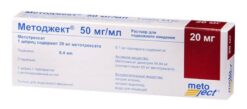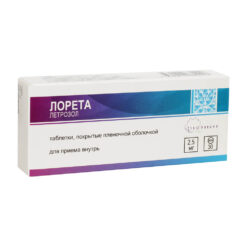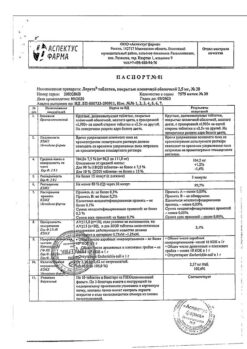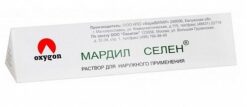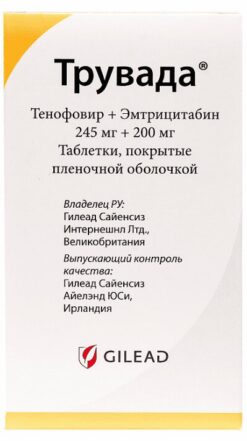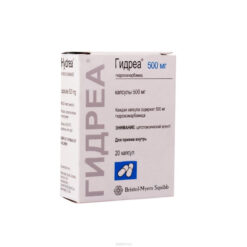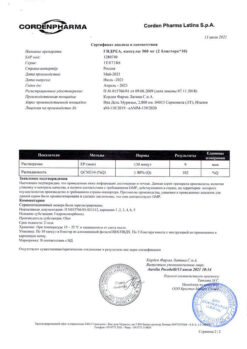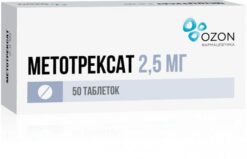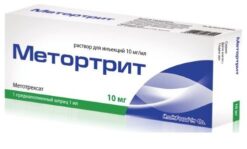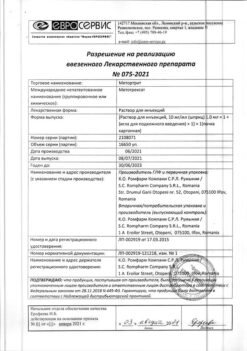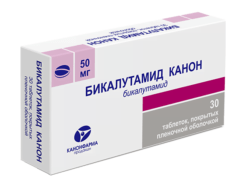No products in the cart.
Description
Pharmacodynamics
The antitumor drug of plant origin. Irinotecan is a semi-synthetic derivative of camptothecin and is a specific inhibitor of the cellular enzyme topoisomerase I. The drug is metabolized in tissues with the formation of active metabolite SN-38, which is superior in its activity to irinotecan. Irinotecan and metabolite SN-38 stabilize the complex of topoisomerase I with DNA, which prevents its replication. In in vivo experiments it was shown that irinotecan is also active against tumors expressing P-glycoprotein of multiple drug resistance (vincristine- and doxorubicin-resistant P388 leukemias).
Pharmacokinetics
The pharmacokinetics of irinotecan and the metabolite SN-38 were studied with a 30-minute IV infusion of the drug at doses of 100-750 mg/m2. The pharmacokinetic profile of irinotecan was not dose-dependent.
Metabolism and distribution
Irinotecan is metabolized in the liver by the enzyme carboxyesterase to form the active metabolite SN-38.
The distribution in plasma is biphasic or triphasic. Mean T1/2 in the first phase of the three-phase model is 12 min, in the second phase 2.5 h, and in the third phase 14.2 h. Cmax irinotecan and SN-38 were reached by the end of the IV infusion at the recommended monotherapy dose of 350 mg/m2 body surface.
The plasma protein binding is approximately 65% for irinotecan and 95% for the metabolite SN-38.
Elimation
In 24 hours, 19.9% is excreted in the urine as unchanged irinotecan and 0.25% as metabolite SN-38.
Pharmacokinetics in Special Clinical Cases
Pharmacokinetic studies have confirmed no effect of 5-fluorouracil and calcium folinate on the pharmacokinetics of irinotecan.
Indications
Indications
Treatment of locally advanced or metastatic colon and rectal cancer:
in combination with 5-fluorouracil and calcium folinate in patients who have not previously received chemotherapy;
in monotherapy in patients with disease progression after conventional treatment.
Pharmacological effect
Pharmacological effect
Pharmacodynamics
Antitumor drug of plant origin. Irinotecan, a semi-synthetic derivative of camptothecin, is a specific inhibitor of the cellular enzyme topoisomerase I. In tissues, the drug is metabolized to form the active metabolite SN-38, which is superior in activity to irinotecan. Irinotecan and the SN-38 metabolite stabilize the topoisomerase I complex with DNA, which prevents its replication. In vivo experiments have shown that irinotecan is also active against tumors expressing multidrug-resistant P-glycoprotein (vincristine- and doxorubicin-resistant leukemia P388).
Pharmacokinetics
The pharmacokinetics of irinotecan and the metabolite SN-38 were studied with a 30-minute IV infusion of the drug at a dose of 100-750 mg/m2. The pharmacokinetic profile of irinotecan was independent of dose.
Metabolism and distribution
Irinotecan is metabolized in the liver by the enzyme carboxylesterase to form the active metabolite SN-38.
Distribution in plasma is two- or three-phase. The average T1/2 in the first phase of the three-phase model is 12 minutes, in the second phase – 2.5 hours, in the third phase – 14.2 hours. Cmax of irinotecan and SN-38 was achieved by the end of the IV infusion at a dose of 350 mg/m2 body surface area recommended for monotherapy.
Plasma protein binding is approximately 65% for irinotecan, 95% for the metabolite SN-38.
Removal
Within 24 hours, 19.9% is excreted in the urine as unchanged irinotecan and 0.25% as the metabolite SN-38.
Pharmacokinetics in special clinical situations
Pharmacokinetic studies confirmed the lack of influence of 5-fluorouracil and calcium folinate on the pharmacokinetics of irinotecan.
Special instructions
Special instructions
Treatment with the drug should be carried out in specialized chemotherapy departments and only under the supervision of a physician with experience in working with anticancer drugs.
The drug should be prescribed with caution to patients who have previously received radiation therapy to the abdominal or pelvic area, patients who have previously had hyperleukocytosis, as well as patients with a general condition on the WHO scale ≥2, female patients; in all these cases the risk of developing diarrhea increases.
Diarrhea that occurs as a consequence of the cytostatic effect of the drug (delayed diarrhea) is usually observed no earlier than 24 hours after administration of Campto (in most patients, on average, after 5 days).
When the first episode of loose stool occurs, it is necessary to prescribe plenty of fluids containing electrolytes and immediately carry out antidiarrheal therapy, including loperamide in high doses (4 mg at the first dose, then 2 mg every 2 hours).
This therapy is continued for another 12 hours following the last episode of loose stool (but not more than 48 hours due to the risk of developing intestinal paresis). If diarrhea is assessed as severe (more than 6 episodes of loose stools per day or severe tenesmus), and also if it is accompanied by vomiting or fever, the patient should be urgently hospitalized for comprehensive treatment, including broad-spectrum antibiotics.
For moderate or mild diarrhea (less than 6 episodes of loose stools per day and moderate tenesmus), which does not stop within the first 48 hours, oral antibiotics with a broad spectrum of action are started, and it is recommended to hospitalize the patient. When diarrhea and severe neutropenia (white blood cell count less than 500/μl) occur simultaneously, broad-spectrum antibiotics are prescribed orally for prophylactic purposes in addition to antidiarrheal therapy.
Loperamide should not be prescribed prophylactically, incl. patients who have had diarrhea during previous administrations of Campto.
The patient should be informed about the possibility of developing diarrhea. Patients should inform their physician immediately if diarrhea occurs (so that antidiarrheal therapy can be started immediately).
With inadequate treatment of diarrhea, a life-threatening condition may develop, especially if diarrhea develops against the background of neutropenia.
Patients with febrile neutropenia (body temperature ≥38°C and neutrophil count ≤1000/μL) should immediately begin antibiotic therapy in a hospital setting.
With the development of acute cholinergic syndrome, in the absence of contraindications, subcutaneous administration of atropine at a dose of 0.25 mg is indicated. Caution should be exercised when using the drug in patients with bronchial asthma. For patients with a history of indications of the development of acute cholinergic syndrome (including severe forms), prophylactic administration of atropine sulfate is recommended before prescribing Campto.
Given that Campto contains sorbitol, the drug is not prescribed to patients with hereditary fructose intolerance.
In patients receiving Campto, it is necessary to perform a complete clinical blood count and monitor liver function weekly.
Impact on the ability to drive vehicles and other mechanisms that require increased concentration
Patients should be warned about the possibility of dizziness and visual disturbances that develop within 24 hours after administration of Campto during treatment with Campto. If these symptoms occur, patients are advised to refrain from driving or using other machinery.
Active ingredient
Active ingredient
Irinotecan
Composition
Composition
1 ml (1 bottle) contains:
Active substances:
irinotecan hydrochloride trihydrate 20 mg (300 mg), which corresponds to an irinotecan content of 17.33 mg (259.95 mg).
Excipients:
sorbitol,
lactic acid,
sodium hydroxide and hydrochloric acid (up to pH 3.5),
water d/i.
Pregnancy
Pregnancy
The drug is contraindicated for use during pregnancy and lactation (breastfeeding).
Patients of reproductive age should avoid conceiving while using the drug and for at least 3 months after its discontinuation.
Contraindications
Contraindications
Hypersensitivity to irinotecan or other components of the drug;
nonspecific ulcerative colitis and/or intestinal obstruction;
pronounced inhibition of bone marrow hematopoiesis;
bilirubin level in the blood exceeding more than 3 times the ULN;
general condition of patients, assessed according to the WHO scale>2;
pregnancy;
lactation (breastfeeding).
Side Effects
Side Effects
From the hematopoietic system: neutropenia – in 78.7% of patients with monotherapy (82.5% with combination chemotherapy), incl. 22.6% of patients had severe neutropenia (neutrophil count less than 500/μl). Neutropenia is reversible and not cumulative. Complete restoration of the number of neutrophils usually occurs on day 22 when using Campto as monotherapy and on days 7-8 when using Campto as part of combination therapy. Fever combined with severe neutropenia was noted in 6.2% and 3.4% of patients, respectively. Infectious complications during monotherapy occurred in 10.3% of patients, in 5.3% of patients – in combination with severe neutropenia. Infectious complications during combination therapy occurred in approximately 2% of patients (0.5% of cycles), in approximately 2.1% of patients and in 0.5% of cycles they were combined with severe neutropenia.
Anemia with monotherapy is observed in 58.7% of patients, with combination chemotherapy – in 97.2%.
Thrombocytopenia (platelet count less than 100,000/μl) is observed in 7.4% of patients with monotherapy, and with combination therapy – in 32.6% of patients. When Campto was used as part of combination chemotherapy, no significant thrombocytopenia was observed. The platelet count is restored by day 22.
There was 1 case of thrombocytopenia in combination with the formation of antiplatelet antibodies.
From the digestive system: nausea, vomiting, diarrhea, abdominal pain, anorexia, mucositis, constipation. Rare cases of pseudomembranous colitis, intestinal obstruction, gastrointestinal bleeding, intestinal perforation, and increased amylase or lipase levels have been reported.
When using the drug as monotherapy, severe diarrhea was observed in 20% of patients (as part of combination therapy – in 13.1%), who followed the recommendations for the treatment of diarrhea. The average time to the appearance of the first loose stool after Campto administration was 5 days.
When using Campto alone, approximately 10% of patients using antiemetics experienced severe nausea and vomiting. When Campto was used as part of combination therapy, severe nausea and vomiting were observed less frequently – in 2.1% and 2.8%, respectively.
Acute cholinergic syndrome: early diarrhea, abdominal pain, increased sweating, conjunctivitis, rhinitis, decreased blood pressure, vasodilation, lacrimation, salivation, chills, malaise, dizziness, visual disturbances, miosis, was observed in 9% of patients receiving Campto as monotherapy (in 1.4% – as part of combination therapy). All symptoms disappear after administration of atropine.
From the central nervous system and peripheral nervous system: involuntary muscle twitching or cramps, paresthesia, asthenia.
Allergic reactions: rarely – skin rash, very rarely – anaphylactic shock.
Other: alopecia, fever, local reactions, transient increase in the level of transaminases, alkaline phosphatase, bilirubin and creatinine in the blood serum. In rare cases, the development of renal failure, arterial hypotension, and circulatory failure has been observed in patients who have suffered episodes of dehydration associated with diarrhea and/or vomiting, or in patients with sepsis.
Interaction
Interaction
Since Campto has anticholinesterase activity, there may be an increase in the duration of neuromuscular blockade when used concomitantly with suxamethonium and an antagonistic interaction with respect to neuromuscular blockade when combined with non-depolarizing muscle relaxants.
Pharmaceutical interactions
Campto should not be mixed with other drugs in the same bottle.
Overdose
Overdose
The main expected symptoms of overdose are neutropenia and diarrhea. If necessary, carry out symptomatic therapy. There is no specific antidote.
Storage conditions
Storage conditions
In a dry place, at a temperature not exceeding 25 °C
Shelf life
Shelf life
3 years
Manufacturer
Manufacturer
USA
Additional information
| Shelf life | 3 years |
|---|---|
| Conditions of storage | In a dry place, at a temperature not exceeding 25 °C |
| Manufacturer | Pfizer, Puerto Rico |
| Medication form | concentrate for preparation of infusion solution |
| Brand | Pfizer |
Related products
Buy Campto CS, 20 mg/ml concentrate 15 ml with delivery to USA, UK, Europe and over 120 other countries.


